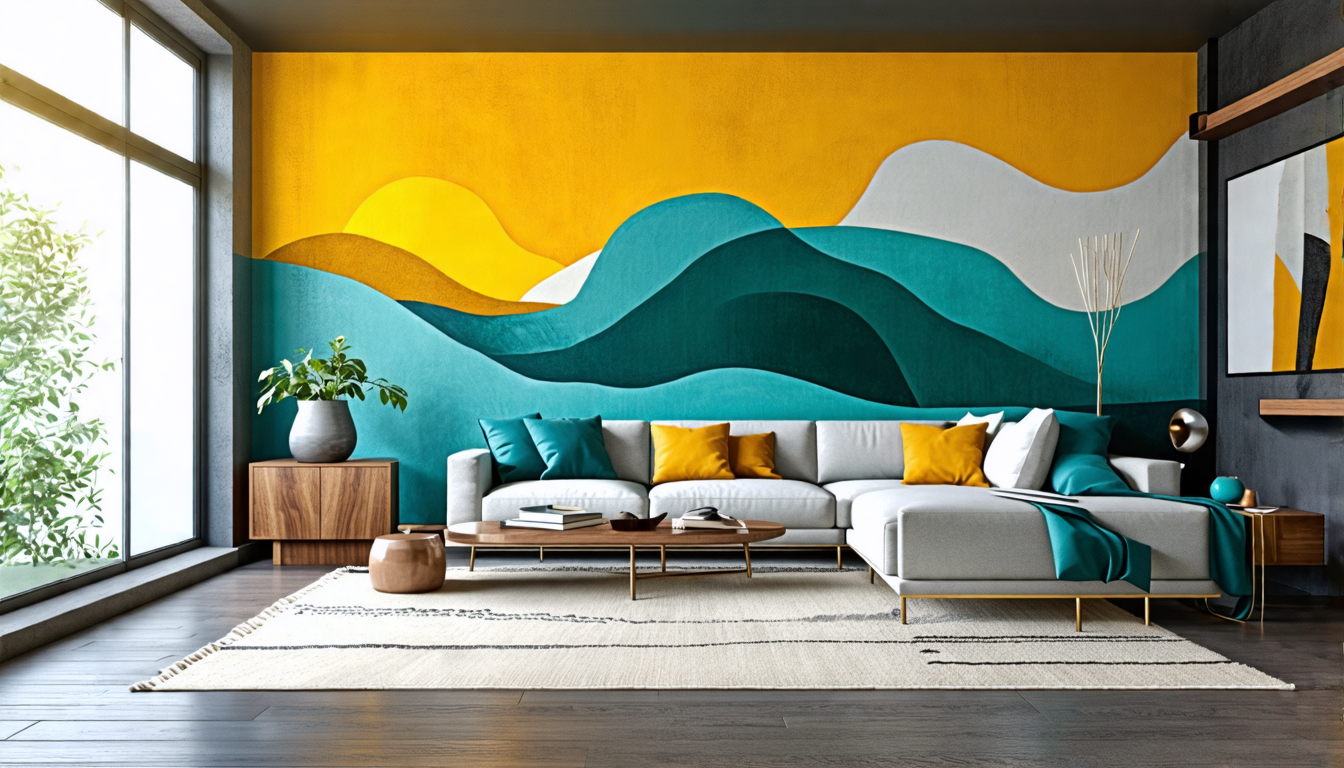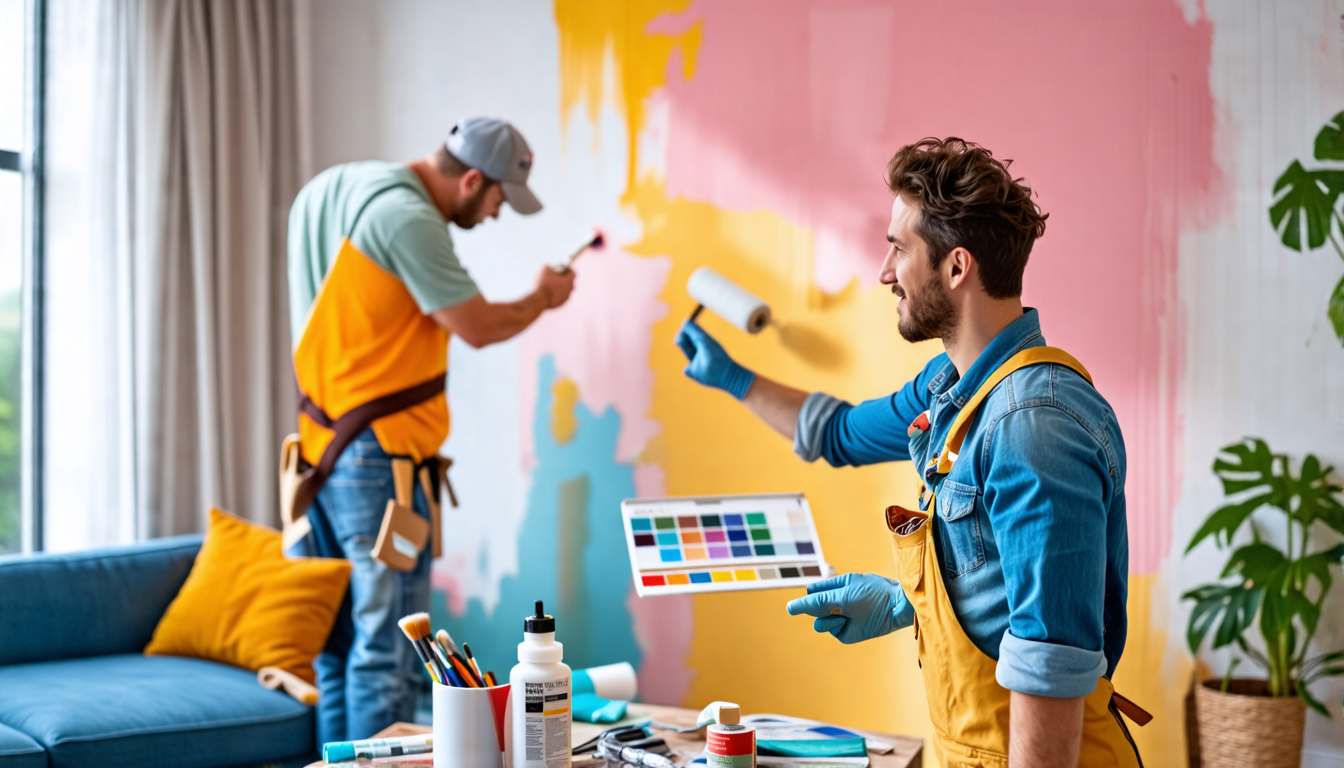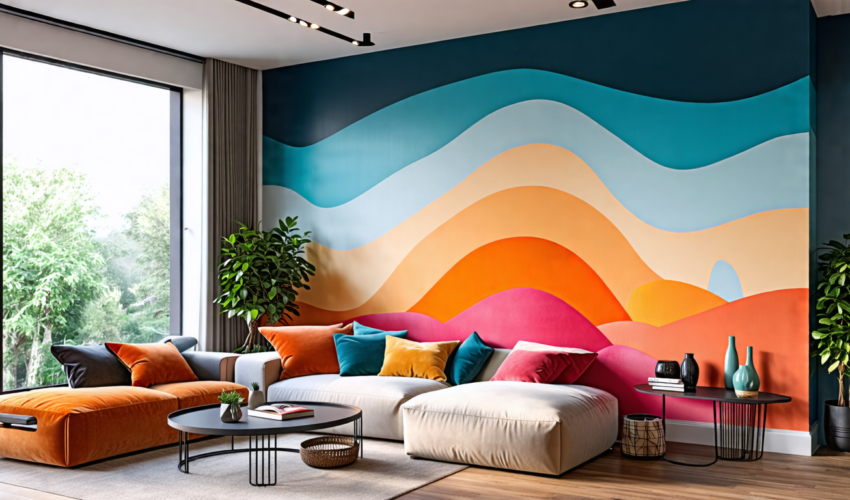Transform your home into a masterpiece with the art of interior painting, a powerful tool for homeowners looking to revamp their living spaces with style and elegance. As the foundation for any visually appealing room, understanding the basics of interior painting is essential. Whether you’re exploring various styles or selecting colors and finishes that best enhance your space, the journey begins with making informed choices. Preparing your walls and surfaces is key to achieving that coveted professional-looking finish, setting the stage for your creativity to shine.
Elevate your home’s aesthetic with innovative painting techniques that bring a modern flair to your interior design. Discover the dynamic effects of ombré walls, indulge in the detail of stenciling, or add intrigue with geometric patterns. For those looking to make a statement, accent walls and focal points can serve as eye-catching design elements, instantly transforming any room. In today’s conscientious world, eco-friendly interior painting practices have become crucial, offering sustainable options that maintain a healthier home environment without compromising on style.
Whether you’re undertaking a DIY project or seeking the guidance of professionals, the journey to a seamless transformation is made easier with the right insights and advice. Equip yourself with step-by-step guides, essential tools, and safety measures for a successful painting experience that avoids common pitfalls. For more complex projects, understanding when to hire a professional can make all the difference, ensuring your vision comes to life with expert precision. Dive into the vibrant world of interior painting and watch as your home transforms into a haven of stunning colors and designs.
Understanding the Basics of Interior Painting: A Foundation for Stunning Transformations
What is Interior Painting? Exploring the Essential Concepts and Styles
Interior painting is an integral aspect of home decoration and renovation, playing a crucial role in the overall aesthetic appeal and atmosphere of your living spaces. Fundamentally, it involves applying paint to the walls, ceilings, and other surfaces within a home, transforming the ordinary into the extraordinary. This art is not just about adding color to walls; it’s about setting the tone, creating moods, and expressing personal style. Various painting styles have emerged, ranging from classic and traditional to modern and eclectic, allowing homeowners to tailor their spaces to reflect individuality and taste.
One of the most popular styles in interior painting is the minimalist approach, where the color palette is kept neutral, focusing on simplicity and clean lines. Contrastingly, the bohemian style embraces bold colors and eclectic mixes, often employing various textures and patterns to create a vibrant and welcoming ambiance. Regardless of the style chosen, the goal is to harmonize the home’s architectural features with the interior décor, leading to a cohesive and inviting environment.
Choosing the Right Paint: Tips for Selecting Colors, Finishes, and Brands to Enhance Your Space
Choosing the right paint is an integral step in achieving a successful interior painting project. The myriad of available colors, finishes, and brands can be overwhelming, so understanding these elements is crucial. Start by considering the color palette that complements the existing furniture and décor. Warm tones like reds and yellows can create a cozy and inviting atmosphere, while cooler shades like blues and greens often evoke a sense of calm and tranquility. Neutral tones, such as whites, grays, and beiges, are versatile and provide a timeless backdrop that can be easily updated with accessories and textiles.
The finish of the paint is equally significant, with options ranging from matte to high gloss. Matte finishes offer a smooth, non-reflective appearance, ideal for hiding imperfections on walls, while eggshell or satin finishes provide slightly more luster and are easier to clean, making them great for high-traffic areas. Semi-gloss and high-gloss finishes are durable and moisture-resistant, making them perfect for kitchens and bathrooms.
When it comes to brands, opt for reputable companies known for their quality and longevity. Brands like Sherwin-Williams, Benjamin Moore, and Behr are industry leaders, offering a wide range of products that cater to different style preferences and performance needs. Consider environmentally friendly options with low VOCs (volatile organic compounds) to maintain a healthy indoor air quality.
Preparing Your Space: How to Effectively Prep Walls and Surfaces for a Professional-Looking Finish
Preparation is the key to achieving a professional-looking finish in interior painting. Properly prepping your space can significantly affect the outcome, ensuring smooth application and long-lasting results. Start by removing all furniture and decor from the room, or cover them with protective sheets to prevent damage from paint splatters. Cleaning the walls is essential; dust, dirt, and grease can prevent paint from adhering well. You can use mild soap and water to clean surfaces thoroughly, especially in kitchens and bathrooms where residues are more prevalent.
Next, inspect the walls for any imperfections such as cracks, holes, or uneven surfaces. Use a spackling compound to fill in gaps and sand them smooth once dried. Sanding is crucial for a seamless finish, as it levels the surface and enhances paint adhesion. Taping off areas like trims, edges, and electrical outlets with painter’s tape ensures sharp, clean lines and prevents unintentional bleeding of paint.
Priming the walls is a step often overlooked but vital, especially if transitioning from dark to light colors or painting new drywall. A quality primer creates an even base, allowing the paint to adhere correctly and ensuring color accuracy. It also seals the surface, enhancing durability and reducing the number of paint coats needed. By investing time in the preparation phase, you set a solid foundation that supports the overall transformation of your home through stunning interior painting.

Innovative Interior Painting Techniques to Elevate Your Home’s Aesthetic
Creative Painting Techniques: Ombré Walls, Stenciling, and Geometric Patterns for a Modern Touch
Transforming your home with interior painting isn’t limited to merely changing colors or updating old coats. Innovative interior painting techniques like ombré walls, stenciling, and geometric patterns can profoundly enhance your space and cater to the modern aesthetic your home deserves.
Ombré walls are a sophisticated and trendy painting style that gradually blends colors from light to dark, seamlessly transitioning hues to create a calming yet striking visual effect. This technique can evoke emotions and add depth to a room, making it an excellent choice for living rooms or bedrooms where you desire a serene atmosphere. To achieve this, select colors that belong to the same color family, use a large flat brush for blending, and work quickly to maintain a consistent wet edge across your wall.
Stenciling, on the other hand, allows for intricate designs and personal customization without the complexity of freehand art. Stencils are perfect for those looking to add a personal touch or design statement to their interior painting projects. Using pre-made or custom stencils, you can introduce elaborate patterns or simple motifs—such as leaves, flowers, or abstract designs—onto your walls. The key to successful stenciling lies in securing your stencil correctly to the wall and applying paint with a dense foam roller to avoid bleeding.
For those seeking a modern, vibrant touch, geometric patterns offer a contemporary flare that’s both chic and eye-catching. This technique involves the artful use of shapes and lines to create structured, repeatable designs that add volume and contrast to your rooms. Whether you’re looking for zigzags, stripes, or more complex patterns like hexagons, the secret is in precise tape application and a carefully planned layout. To ensure sharp lines, always remove the tape when the paint is slightly wet.
Accent Walls and Focal Points: Using Interior Painting to Create Eye-Catching Design Elements
Accent walls are an incredible tool in the arsenal of interior painting techniques that can alter a room’s dynamics with minimal effort. By choosing one wall to highlight, you can create a strong focal point that elevates the entire space. The choice of color and technique for an accent wall hinges on the room’s existing decor and the mood you wish to impart.
Bold colors like deep blues, rich greens, or fiery reds often work best for accent walls, providing a striking contrast against neutral surroundings. However, if you’re feeling adventurous, consider incorporating textured paint or a metallic finish for a unique twist. Beyond color, integrating techniques such as ombré or geometric patterns discussed earlier can further amplify the wall’s impact, turning it into a piece of art in its own right.
In spaces like dining rooms or entryways, accent walls beckon attention, drawing eyes to architectural features or cherished artwork. For a more cohesive look, tie the accent wall’s colors or patterns to elements within your furnishings, such as throw pillows, rugs, or curtains.
Eco-Friendly Interior Painting: Sustainable Practices and Products to Consider for a Healthier Home
Incorporating eco-friendly practices into interior painting is not just a trend but a vital step towards a sustainable and healthier home. Choosing low or zero Volatile Organic Compounds (VOC) paints can significantly minimize harmful emissions, contributing to better indoor air quality. These paints are formulated to release fewer chemicals, making them an ideal choice for nurseries or bedrooms.
Moreover, consider brands that prioritize environmentally-responsible products—these often involve natural ingredients or recycled materials—and openly provide transparency about their sustainability practices. Beyond paint, using brushes with bamboo handles or rollers with recycled foam can further lessen environmental impact.
Embrace sustainable painting practices by reducing waste: estimate the correct amount of paint to avoid excess, store leftovers properly for touch-ups, and recycle empty cans. Eco-friendly interior painting not only beautifies your home but also ensures that your health and the planet are protected, making it a responsible and attractive choice for conscientious homeowners.
By harnessing the power of these innovative interior painting techniques, you can dramatically transform the aesthetic of your home, reflecting your personal style while ensuring the beauty, health, and sustainability of your living environment.

DIY Interior Painting Tips and Professional Advice for a Seamless Transformation
Step-by-Step Guide to DIY Interior Painting: Tools, Tips, and Safety Measures for Homeowners
Embarking on a DIY interior painting project can be both rewarding and cost-effective. However, achieving a professional finish requires careful planning and execution. Start by gathering all the necessary tools: high-quality brushes, rollers, painter’s tape, drop cloths, and a sturdy ladder. Investing in quality supplies will enhance your interior painting experience and ensure better results.
Preparation is crucial. Begin by cleaning the walls to remove dust and grime. Fill in any nail holes or cracks with spackle, sand them smooth, and wipe the surfaces again. Prime the walls if you’re making a drastic color change or painting over a patchy surface. During the painting process, use painter’s tape to protect trim, ceilings, and other areas from unwanted paint splatters.
When applying paint, use the right technique. Dip your brush no more than a third of the way into the paint to avoid dripping, and start painting from the top of the wall, moving downwards. Apply paint in a ‘W’ or ‘M’ pattern to ensure an even distribution, and work in small sections. Remember to keep the room well-ventilated and take breaks to avoid fatigue.
Common Mistakes in Interior Painting and How to Avoid Them for Flawless Results
Even seasoned DIY enthusiasts can make mistakes. One frequent error is neglecting wall preparation. Inadequately prepared surfaces can lead to peeling or uneven finishes. Similarly, using low-quality brushes or rollers can result in streaks or lint in your paint. Always opt for professional-grade equipment for a smoother finish.
Another common mistake is rushing the paint drying process. Allow adequate drying time according to the paint manufacturer’s instructions between coats. This prevents smudging and ensures each layer adheres correctly. Avoid using too much paint at once, which can cause drips; it’s better to apply multiple thin coats than one thick layer.
Pay attention to environmental conditions as well. Painting on a humid day can slow the drying process, while painting in extreme heat can cause the paint to dry too quickly, leading to brush marks. Choose a moderate day for optimal painting conditions if possible.
When to Hire a Professional: Understanding the Benefits of Expert Help for Complex Interior Painting Projects
While DIY interior painting can be fulfilling, some projects demand professional expertise. If your home includes high ceilings, intricate molding, or historic features, hiring a professional painter can ensure these elements are preserved and showcased. Professionals bring experience, precision, and materials that guarantee a lasting finish.
Additionally, complex design techniques, such as faux finishes or detailed murals, require a skill level beyond that of most DIYers. Professionals can execute these intricate details with the necessary expertise to enhance your home’s aesthetic.
Hiring a professional can also be advantageous when limited by time constraints. A dedicated team can complete large jobs efficiently and with minimal disruption to your daily activities. Ultimately, the cost of professional interior painting is an investment in the value and aesthetic appeal of your home.
In conclusion, transforming your home through stunning interior painting techniques is an accessible and impactful way to rejuvenate your living space. By understanding the basics of interior painting, selecting the right paint colors and finishes, and properly preparing your walls, you lay the foundation for a successful and visually appealing makeover. Exploring innovative techniques such as ombré walls, stenciling, and geometric patterns can elevate your home’s aesthetic, while accent walls and eco-friendly practices can contribute to a healthier and more personalized environment. Whether tackling the project on your own or seeking professional assistance, following a step-by-step approach, avoiding common pitfalls, and recognizing when to enlist expert help ensures a seamless and rewarding transformation. Ultimately, interior painting offers a versatile and creative tool for expressing your style, enhancing functionality, and creating a welcoming atmosphere that reflects your unique personality and lifestyle. By embracing these strategies, homeowners can achieve a stunning transformation that goes beyond mere decoration, elevating their homes into spaces of beauty, comfort, and sustainable living.

